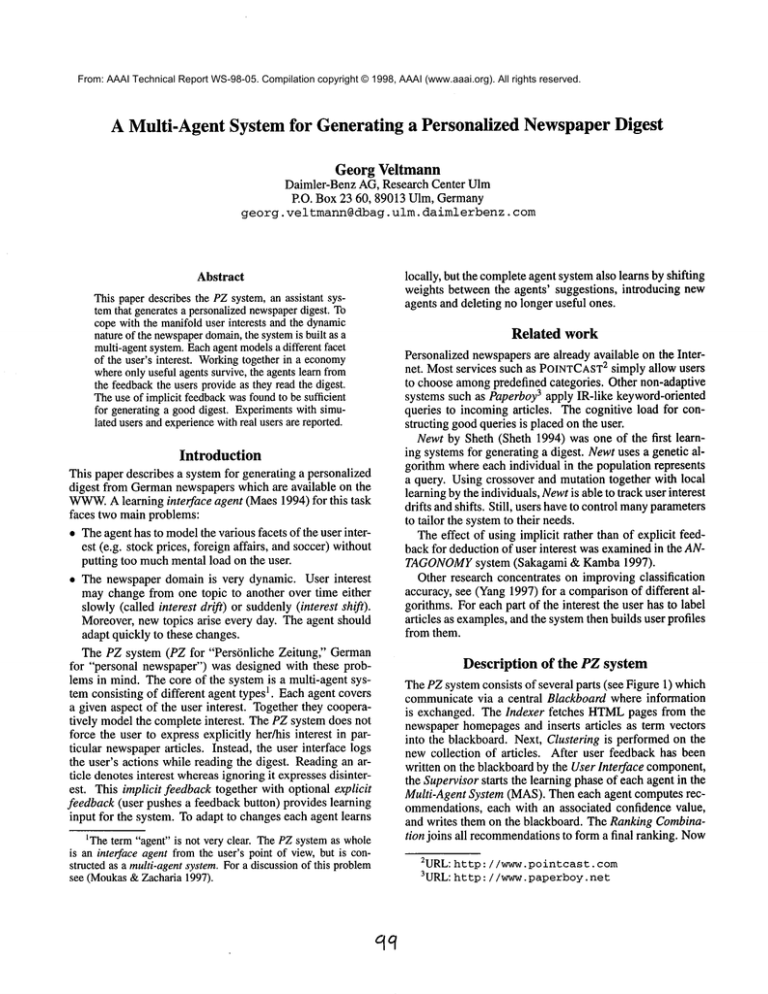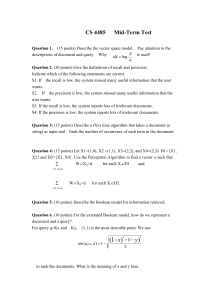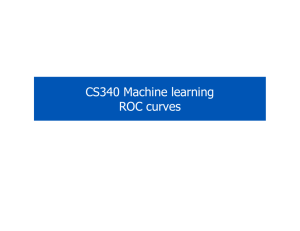
From: AAAI Technical Report WS-98-05. Compilation copyright © 1998, AAAI (www.aaai.org). All rights reserved.
A Multi-Agent System for Generating a Personalized
Newspaper Digest
Georg Veltmann
Daimler-Benz AG, Research Center Ulm
P.O. Box 23 60, 89013 Ulm, Germany
georg, vel tmann@dbag,ulm. daimlerbenz,com
Abstract
This paperdescribes the PZsystem, an assistant systemthat generatesa personalizednewspaper
digest. To
copewith the manifolduser interests and the dynamic
natureof the newspaper
domain,the systemis built as a
multi-agentsystem.Eachagent modelsa different facet
of the user’s interest. Workingtogether in a economy
whereonlyuseful agentssurvive, the agents learn from
the feedbackthe users provideas they read the digest.
Theuse of implicit feedbackwasfoundto be sufficient
for generatinga gooddigest. Experimentswith simulated users andexperiencewithreal users are reported.
Introduction
This paper describes a system for generating a personalized
digest from Germannewspapers which are available on the
WWW.
A learning interface agent (Maes1994) for this task
faces two main problems:
¯ Theagent has to modelthe various facets of the user interest (e.g. stock prices, foreign affairs, and soccer) without
putting too muchmental load on the user.
¯ The newspaper domain is very dynamic. User interest
maychange from one topic to another over time either
slowly (called interest drift) or suddenly(interest shift).
Moreover,new topics arise every day. The agent should
adapt quickly to these changes.
The PZ system (PZ for "PersOnliche Zeitung," German
for "personal newspaper") was designed with these problems in mind. The core of the system is a multi-agent system consisting of different agent types1. Eachagent covers
a given aspect of the user interest. Togetherthey cooperatively modelthe complete interest. The PZ system does not
force the user to express explicitly her/his interest in particular newspaperarticles. Instead, the user interface logs
the user’s actions while reading the digest. Readingan article denotes interest whereasignoring it expresses disinterest. This implicit feedback together with optional explicit
feedback (user pushes a feedback button) provides learning
input for the system. To adapt to changes each agent learns
~Theterm "agent" is not very clear. ThePZ systemas whole
is an interface agentfromthe user’s point of view,but is constructed as a multi-agentsystem.Fora discussionof this problem
see (Moukas&Zacharia 1997).
locally, but the completeagent systemalso learns by shifting
weights between the agents’ suggestions, introducing new
agents and deleting no longer useful ones.
Related work
Personalized newspapersare already available on the Inter2 simply allow users
net. Most services such as POINTCAST
to choose amongpredefined categories. Other non-adaptive
systems such as Paperboy3 apply IR-like keyword-oriented
queries to incomingarticles. The cognitive load for constructing goodqueries is placed on the user.
Newt by Sheth (Sheth 1994) was one of the first learning systems for generating a digest. Newtuses a genetic algorithm where each individual in the population represents
a query. Using crossover and mutation together with local
learning by the individuals, Newtis able to track user interest
drifts and shifts. Still, users haveto control manyparameters
to tailor the systemto their needs.
The effect of using implicit rather than of explicit feedback for deduction of user interest was examinedin the ANTAGONOMY
system (Sakagami & Kamba1997).
Other research concentrates on improving classification
accuracy, see (Yang1997) for a comparisonof different algorithms. For each part of the interest the user has to label
articles as examples,and the systemthen builds user profiles
from them.
Descriptionof the PZsystem
The PZ systemconsists of several parts (see Figure 1) which
communicatevia a central Blackboard where information
is exchanged. The Indexer fetches HTML
pages from the
newspaperhomepagesand inserts articles as term vectors
into the blackboard. Next, Clustering is performed on the
new collection of articles. After user feedback has been
written on the blackboard by the User Interface component,
the Supervisorstarts the learning phaseof each agent in the
Multi-Agent System (MAS).Then each agent computes recommendations,each with an associated confidence value,
and writes them on the blackboard. The Ranking Combination joins all recommendations
to form a final ranking. Now
2URL:http://www.pointcast.com
3URL:http://www.paperboy.net
Supervisor
Clustering
~’.~
Ranking
Combination
.~
User
Vectors ClusterFeedback
PZ
WWW
Server
Final
UserFeedback Ranking
HTML
Pages
Text,Cluster,
Indexer
User
Feedback
UserInterface
UserFeedback
__.¢
"N N
I
i
I
\
General
Agent
.....
Cluster
Agent
Section
Agents
[~-"
Topic
Agents /
’
= Multi-Agent
I System
I
Figure 1: Overviewof the PZ system
their attention on one newspapersection such as economics
or science. For special topics of user interest (expressed by
giving positive explicit feedbackfor an article), TopicAgents
(TA)are created. These three agent types use Rocchio’salgorithm (Rocchio 1971) for learning and updating a profile
vector.
Since the goal is to generate a digest containing selected
articles and not to rank the wholecollection, agents insert
recommendations
in the blackboard only if their confidence
measuredby the cosine coefficent betweenthe article vector
and the profile vector is abovea given threshold 0, whichis
adjusted in every learning phase.
Whileit is clear whatarticles are positive or negativeexamples for GAand SAlearning, TAlearning is different.
Onlyarticles related to the topic should influence the profile vector update in order to maintainspecificity. Therefore
only articles with a cosine greater than (9 (here set to 0.08)
with respect to the old TAprofile vector are used as learning examples. This technique is similar to query zoning as
described in (Singhal, Mitra, & Buckley1997).
Whenthe PZ system is used over a long period of time,
the profile vectors tend to grow.Interest drift causes the inclusion of newterms to the vectors and makesold terms obsolete. Thereforeeach entry in the profile vectors has a time
stampwith the date of its last use for calculating the cosine.
If a term has not beenaccessedfor ~- days it is deleted from
the user profile (T wasset to 14 days in the experiments).
The Cluster Agent (CA) does not modelthe user interest
in topics, but rather the user’s interest in up-to-datearticles.
The size of an article cluster gives a measureof actuality
and importance the newspapereditors have assigned to the
topic of the cluster. For eachcluster, the article closest to the
cluster centroid is recommended
to the user.
Learning in the MASEach agent is supplied with a intial energy. Wheneveran agent receives positive feedback
the newdigest can be displayed via the User Interface. Most
system componentsare explained in more detail below.
Indexing
Since PZ has to deal with HTML
pages in different formats
from the newspaperswith muchadministrative content, the
first step cuts out the interesting parts of a newspaperarticle
such as headline, subheadline, date and the bodyof the article. PZ uses GERTWOL
(Haapalainen & Majorin 1994),
morphologicalanalysis system including part-of-speech tagging and stemming,to reduce the numberof features. Only
the stems of nouns, verbs, and adjectives are used as indexing terms. This cuts the numberof features downto 60%of
the original number. TF/IDFweighting is used to compute
term vectors for each article.
Clustering
The aim of the PZ system was to generate a newspaperdigest. It wouldbe useful to group articles belonging to the
same topic together in the display. Therefore the articles
are clustered. Weuse a bottom-up hierarchical clustering
methodwith a group average metric as the clustering criterion (Willet 1988). The cosine betweenarticle vectors
used as the simililarity metric. Theresulting cluster tree is
prunedat a predefined threshold of inter-cluster similarity
(currently 0.13), and only clusters which contain more than
2 articles are preserved.
Multi-Agent System
To modelthe different facets of user interest, the PZ system utilizes different kinds of agents workingtogether in
the MAS.The characteristics of the four agent types and the
learning methodfor the whole MASare explained below.
Agent types The GeneralAgent(GA) monitors all articles
and learns from all user feedback. Section Agents (SA) focus
100
it gets a reward increasing his energy. Analogically, negative feedback decreases energy. Everyagent is also charged
an amount of energy for making a recommendation. Thus,
the numberof possible recommendationsis limited by the
energy of the agent. An obligatory everyday charge ensures
that agents which never recommend
articles do not clog the
system. If the energy of an agent drops belowzero, the supervisor deletes it from the MAS.This economicsystem retains useful agents and discharges ineffective ones.
Each agent marks the feedback it has used for learning.
After all agents have learned, the supervisor checks whether
there are any articles which comefrom a section without
assigned SAand have positive feedback, or any articles with
explicit positive feedback on topics whichhave no assigned
TA.In this case newagents are created using the particular
article as their inital learning example.
User Interface
In order to makethe PZ system accessible for manyusers,
the user interface was implemented as a WWW
server.
Whena user connects to the PZ server, she is identified and
her personalized newspaperdigest is displayed (Figure 2).
A list of newspapersections is shownon the left while the
right frame displays the text of the article. Belowthe text,
all other articles belongingto the samecluster or the same
section are listed. The server counts reading an article as
implicit positive feedback. In the lowermostframe, explicit
positive or negative feedback can be provided.
The systems ability to adapt to changesin user interest can
be tested by defining simulatedusers as introducedby (Sheth
1994). In addition to this, the PZ system was used over a
period of six months by researchers at Daimler-BenzAGto
obtain real user feedback.
Tests with simulated users
Over a two and a half month period 17304articles from 4
different newspaperswere collected. Fourteen topics such as
UNO,soccer, and movies, were identified by the occurrence
of certain keywordsin the article. To test the PZ system, two
different interest profiles weredefined:
T14: This profile assumes a user with various interests.
All defined topics are included. 2444 articles have been
markedwith implicit feedback. The first article of each
topic was markedas having explicit positive feedback to
allowtopic agents to be initiated.
T6-T7:This profile simulates an interest shift. At first,
only six topics are of interest. After 33 days the interest
changesto seven other topics. Nonegative explicit feedbackwas providedfor old interest articles after the shift,
but each topic starts with an article having explicit positive feedback as in T14. Altogether 1362 articles were
marked.
1.0"~
2
0,9
+
0.8~
t
..,
0.7-~
pL
PersOnllche
Zeitung
14.04.1998
TopNews
P’Z- Din
Persenliche
Zeit
ung
0.6~
0.5~
Japanerw|gt weiterl Steuersenkungen
Toklo
(rtt) Die Se
rge er
Ob
d~Jap
~lsche ~chaAsent~ung
Wlr
hst Iro
~r
wlc
des
In d
erverg
angenenmWoct
beschloaa©~n
KonJunl~u¢pl~.
Dies~gnlerendl
Wlrtsch~
stehe
unlcrstKr~
neg=4Jvcm
D~cR,
hel~
e$Im
9estem
vero~enUlcht
enK(mJun~turbedct~
derJapmdschen
Netenb~k.
Zuvor
hattee~~hmnder
Reole~gspol~Ker
gesa~
diemglemnde
LDP
er~,lge
d~dl~te
Ste~menkunge~
Minlsterprlsident
E~taro
Hashlmoto
plant
anoeb~¢h
dine
Aus~eitung
dergeplsnten
Steuersenkungen
urneine8111ion
Yen
(14ivkd,Ma~).
0.40.35
i]
i.]i/,
’
0.2~
Recall......
Recall (sliding mean
over 10 da)Ps)
Precimon.....
:
Precision (sliding meanover10 days) -~-0.0~................. ~ ............ ~..................~...........................
~............................
~......................
t ................
0
10
20
40
60
70
30
50
days
0.1~
KIOSK
Figure 3: Precision and Recall on T14 data
Figure 2: User interface in web browser window
The PZ system focuses the user attention on a small selection of articles. Newtopics are introduced only by the
cluster agent. To allow exploration, users can browseall articles at the "Kiosk" (Germanfor "newsstand"). Here the
articles are sorted by newspaperor by section, and the systems logs only explicit positive feedback.
Experiments
Evaluating a information filtering systemis based mostly on
test collections of documentsrated as relevant or irrelevant.
The results for T14are shownin Figure 3. Precision and
recall are used as evaluation metrics. Wecalculated a sliding mean over 10 days to smooth the curve. The average
precision was 0.44, while average recall was 0.65. The recall curve clearly showsthat the systemslowly learns the interests of the user, whereasprecision is goodfromthe start.
On the average 36 articles were recommended,which means
that 86%of the articles were filtered out. The results for
T6-T7(Figure 4) clearly showthe interest shift on day 34.
Both recall and precision drop significantly but rise quickly
to their previous or (in the case of recall) to an evenhigher
value. The smaller numberof relevant articles causeda loss
in precision (average 0.35) and recall (average 0.6).
1.oo.9
i
...,..’~
, ~
,.
0.8-~
o.,°.°i
o.5 :
/i /i ..."! ..."
,
i’i i /ik 5
o.3~
~,i /f ~i
o.2~
i ~,;
!i
~"
..
/"i
/12i!, /2/
’ i" ’
ii ~’~"iill
i! ’" i !
i/
Recall......
!~ Recall (sliding meanoverlO da)is) --+-Preciston.....
i
Precision (sliding meanover 10 days)
0.0
"1............................
~.............................
~..........................
,...........................
T............
, ........... r...........................
.
70
0
10
20
30
40
50
60
days
0.1
Figure 4: Precision and Recall on T6-T7data
Experiences with real users
For experimentation the PZ system was accessible for 6
months to a group of researchers. Only five of them used
the system on a regular basis. Dueto other workthe digest
was not read every day. Sometimesonly the most interesting
parts of the digest were examined. Therefore the precision
varied even more than in simulated user experiments.
1.0-
0.9
i
0.8-~
0.7-! i’=
0.6-~
0.5~
0.2-~
Precision......
0.1. Precision (sliding meanover 10 days)
Precision on cluster (slldlng mean)
0.0
"1
...................
!...................
i ...................
]...................
i ....................
i ...................
1..................
i ..................
] ...................
i ...................
i
10
20
30
40
50
60
70
80
90
100
days
Figure 5: Precision for user U1
In Figure 5, the results for one user are given for those
days the digest was read. The average precision was 0.46.
This means that nearly half of the recommendedarticles
were read. Scores for other users were similar. Since real
users do not provide feedback on unread articles, no recall
values can be calculated.
The PZ system inundates its users from time to time with
up to ten articles belongingto one cluster. Notall articles
normally get read, since the user is already very well informedafter havingread five articles. If wecount all articles
of a cluster belongingto a article already read as also being
read, then the precision rises on the averageto 0.62 (see top
curve in Figure 5). Onthe average 39 out of 270 articles in
a collection were presented.
Discussion and future work
The PZ system was developedas an interface agent to guide
the user to interesting newspaperarticles. The approach
chosen deals sucessfully with the problems of the newspaper domain. Local and global learning enables the system
to cope with changesin user interest and topics. The various facets of user interest were modeledwith different agent
types. Tests with real users yielded similar performancethan
experimentswith simulated users.
Further workon the filtering effects of the different agent
types is needed.Toolsfor tracking topics and agents haveto
be developed. Moreover,new agent types could be added to
the MAS.Oddity agents recommend
peculiar articles to enhanceexploration of the article collection. Collaborativeilltering agents (Resnick &Varian 1997) select articles based
on recommendations
from other similarly interested users.
References
Haapalainen, M., and Majorin, A. 1994. GERTWOL:
Ein
System zur automatischen WorOeormerkennung
deutscher
WOrter.Lingsoft, Inc.
Maes, P. 1994. Agents that Reduce Workand Information
Overload. Communicationsof the ACM37(7):31-40.
Moukas, A., and Zacharia, G. 1997. Evolving a Multiagent Information Filtering Solution in Amalthea.In Proceedings First International Conference on Autonomous
Agents.
Resnick, P., and Varian, H. R. 1997. Recommender
Systems. Communicationsof the ACM40(3):56-58.
Rocchio, J. J. 1971. Relevance Feedback in Information
Retrieval. In Salton, G., ed., The SMART
Retrieval System: Experiments in Automatic DocumentProcessing. EngelwoodCliffs, NJ: Prentice Hall. 313-323.
Sakagami, H., and Kamba, T. 1997. Learning Personal
Preferences On Online NewspaperArticles FromUser Behaviours. In Proceedingsof the Sixth International World
Wide WebConference.
Sheth, B. D. 1994. A Learning Approachto Personalized
Information Filtering. Master’s thesis, MITDepartmentof
Electrical Engineering and ComputerScience, Cambridge,
MA.
Singhal, A.; Mitra, M.; and Buckley, C. 1997. Learning
Routing Queries in a QueryZone. In Proceedingsof SIGIR
’97, 25-32.
Willet, P. 1988. Recent Trends in Hierarchic Document
Clustering: a Critical Review. Information Processing &
Management24(5):577-597.
Yang, Y. 1997. AnEvaluation of Statistical Approachesto
Text Categorization. Technical Report CMU-CS-97-127,
Carnegie MellonUniversity, Pittsburgh, PA.






